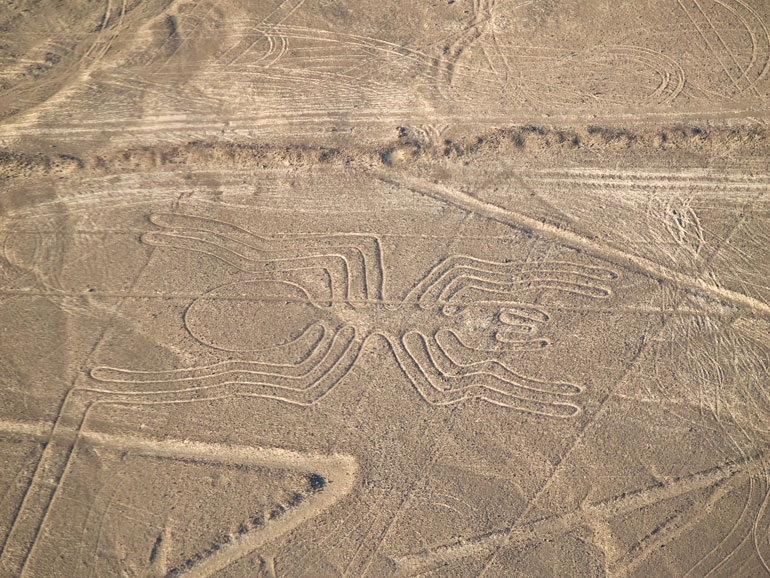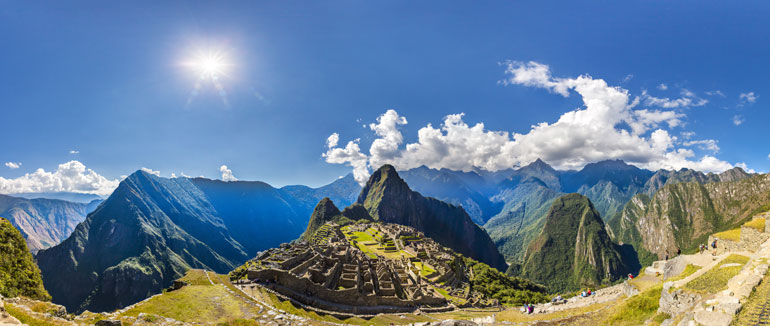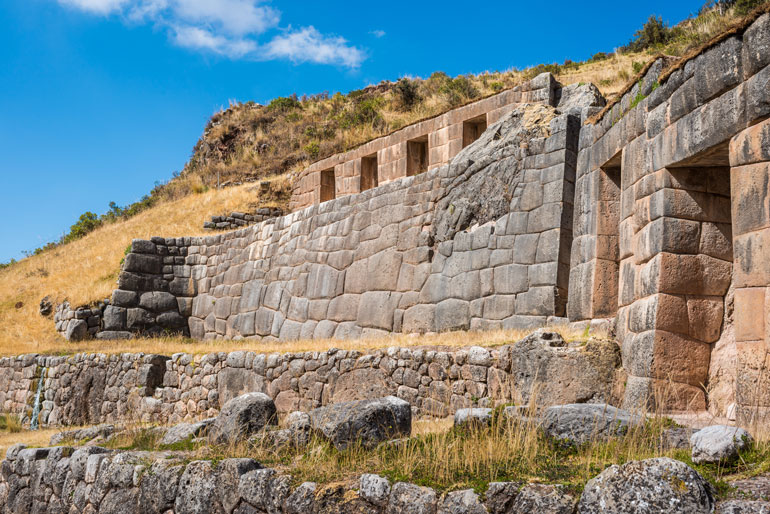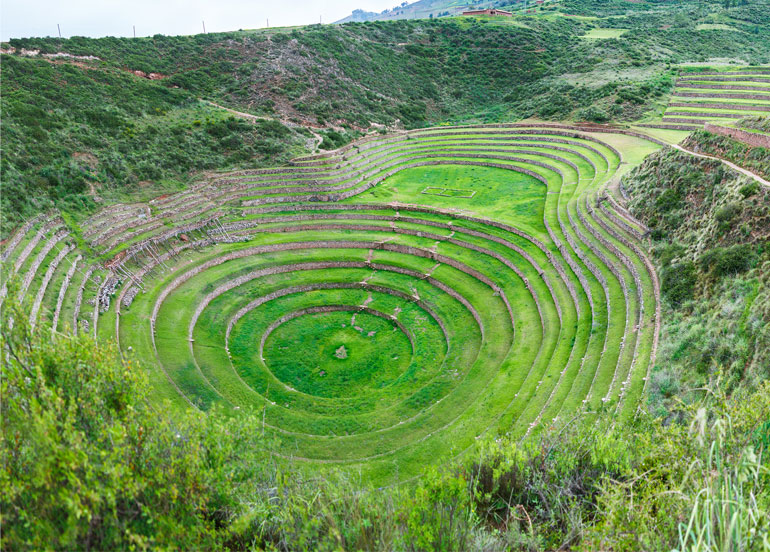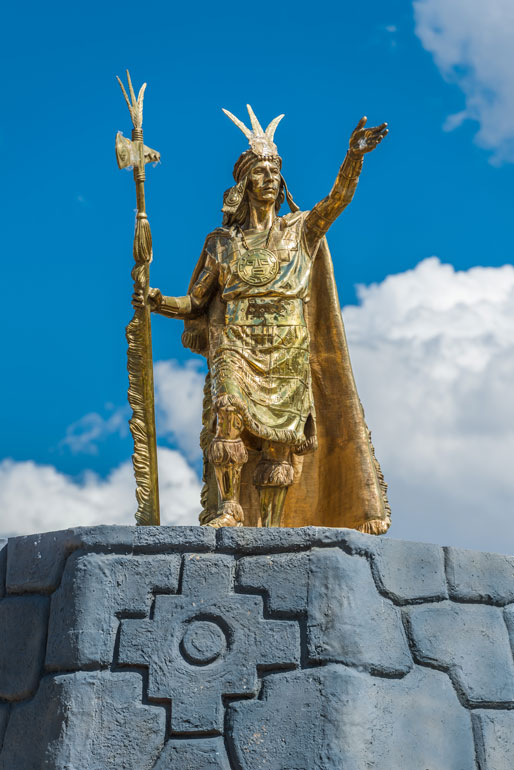The Inca Empire (438 to 1533 when it the Spanish conquistadors began their conquest) was the largest of the Native American empires, covering much of of western South America. Its capital, Cusco, was in the Andes Mountains, and the empire stretched across Peru, Ecuador, Bolivia, the mountains of Argentina, and north and central Chile. The Inca civilisation arose from the highlands of Peru sometime in the early 13th century. It was finally conquered by the Spanish in 1572.
The Incas worshipped a sun god, and believed that their king, the Sapa Inca, was the "son of the sun."
The Inca Empire was unique. It was clearly a very civilised empire, with rules, laws and armies, yet it would not fall into the normal ideas of civilisation because they had not developed writing. They also had not invented many of the things we would regard as essential: they did not have the wheel or wheeled vehicles. They did not have animals to ride, or draught animals that could pull wagons and ploughs, nor did they know about anything beyond the Stone Age; they used soft metals such as gold and silver, but they did not use iron. Yet despite all of this the Incas forged one of the greatest empires in human history up to that time.
The Incas did not have money to trade with, and they did not use markets to exchange goods. Instead, individuals bartered with one another. Their form of tax, was to have to provide a certain amount of work to the Inca empire each year as well as some produce from their land.
The empire gave out some of this surplus food in times of shortage.
The empire, which the Inca called Tawantinsuyu, meaning The Four Regions, was ruled by the nobility class. These were the people known as the Inkas, meaning lordly class. The Inca lords were a small number - less than 40,000 out of a total empire population of 10 million. It was the Spanish who used the name Inca for the whole people and empire, and it is that word which we use today.
The Inca people began as a tribe of animal herders in the Cusco area around the 12th century. For a reason unknown, in about 1438, they began to expand their influence under the command of Sapa Inca (Pachacuti, the paramount leader). It was amazingly rapid and successful. During this time much of the Andes mountains (roughly modern Peru and Ecuador) came under Inca control.
Pachacuti is thought to have built Machu Picchu, either as a family home or summer retreat. It was never meant to be a working capital.
Pachacuti tried to extend his empire by explaining the benefits of joining him, and most surrounding peoples accepted this offer, so saving the problem of going to war.
If they did go to war, the leaders of the conquered area were executed.
The ruler's children from each new region coming under control were brought to Cusco to learn about Inca ways, then sent back, to rule their native lands.The Inca nobility also married these rulers, so embedding their influence on the whole empire.
The son of the Inca ruler led the army. Pachacuti's son Tupac Inca Yupanqui began conquests to the north and continued them as Inca ruler after Pachacuti's death in 1471. Tupac Inca's empire stretched north into modern-day Ecuador and Colombia. Very little was added by later rulers, and those people who lived beyond the empire's borders were not friendly to the Incas, something that would help the Spaniards in later years.
Spanish conquistadors, led by Francisco Pizarro, explored south from what is today Panama, reaching Inca territory by 1526. They were quick to realise that the Inca lands were wealthy, and so worth conquering. In 1529 the Queen of Spain signed a charter allowing Pizarro to conquer the Incas. Pizarro was named governor and captain of all conquests in Peru, or New Castile, as the Spanish then called the land.
At this time, just as in the north with respect to the Aztec, a series of extraordinary co-incidences helped the tiny Spanish band conquer a huge empire. The first of these were an internal struggle for power. As it happened,when Pizarro arrived the Inca nobility were in a civil war. Furthermore, smallpox and other European-brought diseases, had already begun to spread from Central America. It would eventually kill 90% of the Inca. This was important because it left the Inca's severely weakened. Pizarro had a tiny force: just 168 men, one cannon, and 27 horses. But Pizarro worked with the peoples on the edges of the Inca empire who were pleased to see the empire end. This added tens of thousands of native allies to his army. The Spanish also had a way of fighting that was unfamiliar to the Incas. The Incas usually set siege to places they wanted to conquer, and then discussed surrender terms, rather than go into battle. Pizarro met with the Inca leader, Atahualpa, in a supposedly friendly way, then attacked him and and held him as hostage.
Atahualpa offered the Spaniards enough gold to fill the room he was imprisoned in and twice that amount of silver. The Inca fulfilled this ransom, but Pizarro deceived them again, refusing to release Atahualpa afterwards. The Spaniards finally executed him, in August 1533.
By 1572 the last Inca stronghold was conquered, and the last ruler was captured and executed.
After the fall of the Inca Empire many aspects of Inca culture were systematically destroyed, including their farming system. The Spanish made one member of each family work in the gold and silver mines, the most important of which was the silver mine at Potosi.
The Inca believed in reincarnation. Death was a passage to the next world that was full of difficulties. The spirit of the dead, camaquen, would need to follow a long road and during the trip the assistance of a black dog that could see in the dark was required. Most Incas imagined the afterworld had flower-covered fields and snow-capped mountains.
It was important to the Inca that they not die as a result of burning or that the body of the deceased not be incinerated otherwise their chances of reaching the afterlife would be reduced.
The Inca nobility wrapped tight cloth straps around the heads of newborns to shape their soft skulls into a more conical form, thus distinguishing the nobility from other social classes. The Incas made human sacrifices.
The Inca recorded information on groups of knotted strings, known as Quipu, although they can no longer be decoded.
The Incas thought that the coca plant was sacred. Its leaves were used in moderate amounts to lessen hunger and pain during work, but were mostly used for religious and health purposes.
Tracks across the mountains allowed quick movement (on foot) for the Inca army. They built shelters called tambo and storage silos called qullqas one day's travelling distance from each other, so that an army on campaign could always be fed and rested.
Important note
